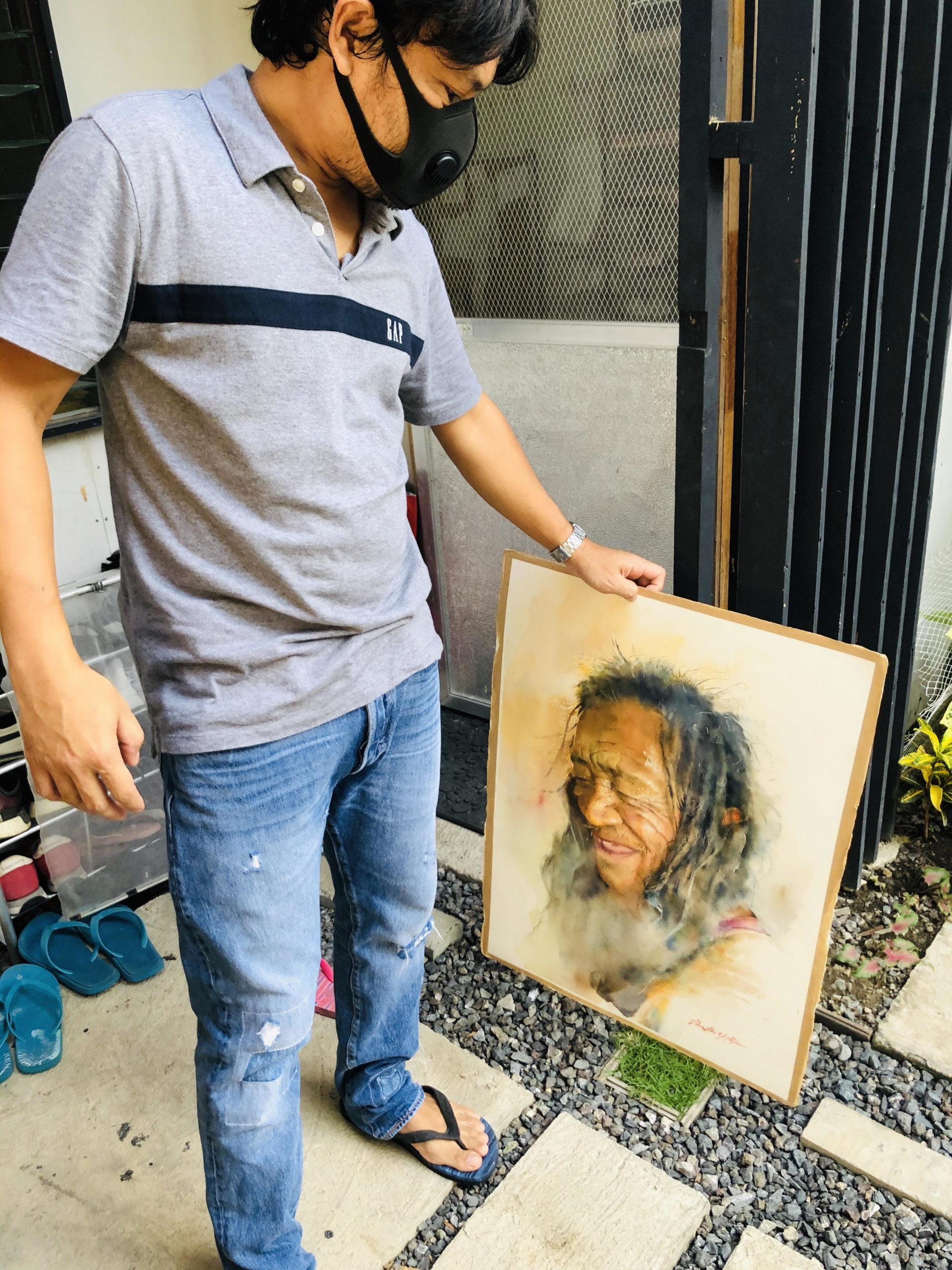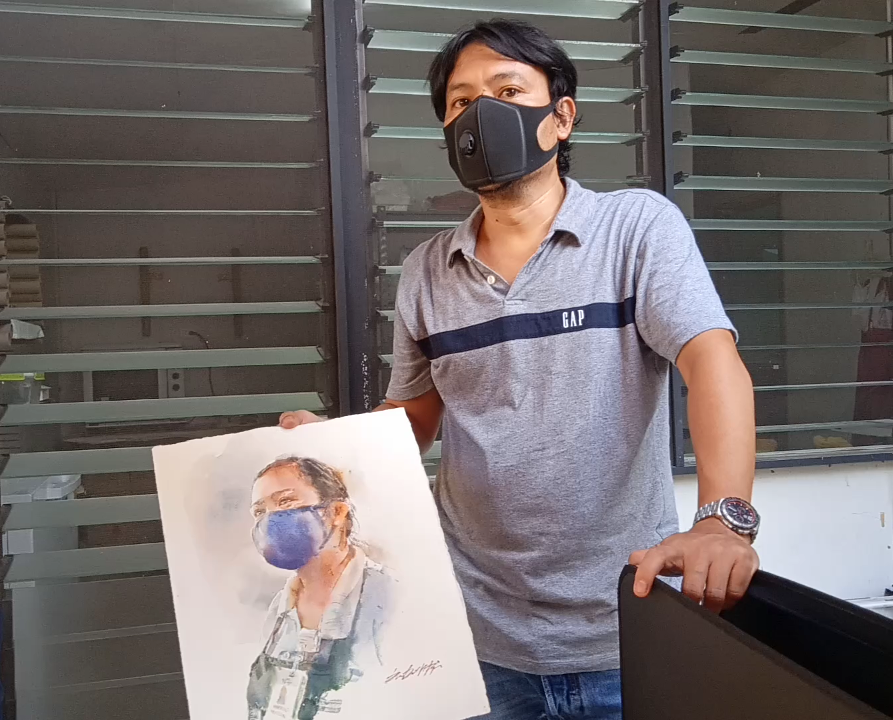CEBU CITY, Philippines — There is more to art and being an artist than showing the beauty of colors, lines, and pictures.
That purpose is sending the message and effecting change.
Architect Dino Dante Pajao started having an interest in painting since he was in elementary and established his love for the form of art during his high school years.

Architect Dino Dante Pajao shows one of his paintings as he explains that every art piece has a story behind it.
But loving the arts, which is traditionally branded as a “no-money” industry, never came easy.
“Daghan kaayo og mo-discourage nga ‘nganong mag-artist man ka nga di man ka mabuhi ana,'” Dino recalls.
(Several people would try to discourage me questioning why I want to be an artist when being one could not support my needs.)
Dino, a native of Southern Leyte, obtained his degree in architecture in a university in Cebu City.
Dino and his wife, Ethelrida, spent 10 years of their married life working in Singapore. Dino, 43, worked as an architect in a firm while Ethel, 42, worked for the Singapore office of a non-government organization (NGO).
Read: FACES OF CEBU: Jimdandy Bercero, 22, fruit vendor
While succeeding in his professional career, Dino has always carried his love for the arts, particularly watercolor painting, which for him, is the fuel that keeps him going.
“At the end of the week, naay mo-fuel nimo para mo-survive ka for another week. Mundane kaayo nga hunahunaon nimo nga wala kay i-look forward for the weekend,” Dino shares.
(At the end of the week, there’s something that will fuel you so you can survive for another week. It’s mundane to think that you’d have nothing to look forward for the weekend.)
Until three years ago, the couple left a more comfortable life in Singapore to pursue a thirst for change and “revolution” in art and how the society perceives it.

Couple Dino and Ethel Pajao, both enthusiasts of watercolor painting, advocate to revolutionize arts as a means of telling a story and effecting change. | Photo/Rhee Telen Jr.
“Ang main reason nga nanguli mi is pareha ta, we were looking for change. Kung magtrabaho ka sa gawas, literally, kung gusto ka mopalit, makapalit gyud ka kay imong sweldo, kung ikumpara nimo diri, medyo taas gyud. For more than 10 years, sige mi og hunahuna nga unsaon man nato nga we leave a mark,” Dino says.
(The main reason we decided to go home is because we were the same, we were looking for change. If we worked abroad, literally, if you wanted to buy something, you’d be able to afford it because your salary is more compared to what you’d earn here. For more than 10 years, we always tried to think of something wherein we could leave a mark.)
The couple returned to the Philippines as they organized events for artists and introduced a professional brand of watercolor, which Dino is a brand ambassador of.
Being a communications graduate and having extensive experience in organizing events, Ethel was involved largely in putting up their exhibits and art demonstration events where she has been exposed to various artists with different styles in their artworks.
“He would always tell me [to] try to make it a point that we cater to everybody [because] art is for everyone,” Ethel says.
“Even before we moved to Cebu, we already saw that there is a change in terms of where art is. I think we really reached a point in time that art was for everyone. The barrier wherein one says ‘I’m not artsy because I don’t draw’ was lost,” she added.
Telling the stories of the pandemic

Architect Dino Dante Pajao shows his portrait of a grocery attendant whose story he learned from one of his visits to a supermarket in Cebu City. The girl walks two kilometers every day to go home after a day’s shift. CDN Digital Photo | Rosalie O. Abatayo
From one of his trips to a supermarket in a mall in Cebu City, Dino came up with a watercolor portrait of one of the grocery attendants, whose story has touched him
“She needs to walk for around two kilometers to get home because there was no public transportation. But for her, she felt blessed because she had a job. I felt that we were privileged because we’re just at home whereas these guys, they don’t have a choice [they need to work] just to be able to eat,” Dino says as he shared the story behind the portrait.
Even Ethel, who first didn’t believe that she could paint, has already picked up the brush.
“What drew me to watercolor is that magic. I say magic because that’s how I felt it when I saw water, like wet brush and you dip it on a squeezed color and put you put it on a paper. it’s like a dance. It’s like water is waiting to be touched by the color. What happens on paper is really like a dance, water embracing the color. That drew me to the medium,” Ethel says.
Learning how to paint, Ethel said, has proven to be worthwhile as she spent the past four months with Cebu City under lockdown.

Ethel Pajao shows her four-piece set of watercolor painting showing the budding, blooming, and withering of one of her roses in her garden.
“I always see painting as a good way to immortalize something beautiful,” she said. /bmjo
